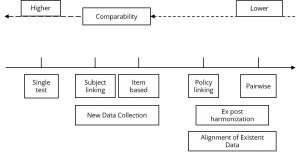
As the SDG 4 indicator 4.1.1 stipulates, Proportion of children and young people (a) in grades 2/3; (b) at the end of primary; and (c) at the end of lower secondary achieving at least minimum proficiency level in (i) reading and (ii) mathematics, by sex, the development and scaling up of learning outcomes is key to a successful achievement of the goal (UNESCO, 2017).
To address the challenges posed by the limited capacity of some countries to implement cross-national, regional, and national assessments, actions have been taken by the UNESCO Institute for Statistics (UIS) and its partners. The UIS proposes a few options to link assessments together; one of these strategies is the Rosetta Stone, a subject-based psychometric linking approach (new data collection). The second one is the Policy linking approach, which consists on setting benchmarks, or cut scores, on learning assignments to align them with other assessments across countries or contexts (alignment with existing data).
Learn more about... |
|
Rosetta Stone |
Policy linking |
The figure below summarizes the degree of comparability of the different methods as well as the use of existing and new data.
Figure 1: Assessing the different options of degree of comparability
